The 2020 Analysis of Higher Education SEO

SEO For Universities, Colleges and Education Websites in 2020
Hey WooNation!
It has been slightly over a year since I last wrote about SEO For Higher Education back in 2019 and what it took to rank universities and colleges on the front page of Google.
Many of you emailed me loving that article. An article that ended up at 8,300+ words and took me weeks to compile and write.
Since that time, we have had 4 Core Google updates, BERT, Maverick, a few un-named Google Algo updates, and COVID-19 which changed a lot of search patterns.
Gee, I wonder if what it takes to rank Higher Ed SEO will be different now, than it was back 15 months ago?
I looked at over 2900+ variables this year and how those could play into making a website rank the front page across many Higher Education marketing keywords. Last year, I only examined about 700 variables. So this audit was much further into the rabbit hole.
And while I don't share the full list of keywords I used in these studies ( because the haters think I'm outing them ) I do share a sample. Anyone with Excel could template the samples and make their own huge list.
Keywords like:
- Criminal Justice Degree Online
- BA in Communication Studies
- Masters of Business Administration Program
- RN to BSN Online No Clinical
- Universities with Exercise Science Degrees
- Associates Degree in Elementary Education
- Affordable Liberal Arts Colleges
- and many many more.
This wasn't a small time SERP analysis.
Results ranged from unique degree programs to cookie-cutter standby's like an MBA. It ranged from private faith-based school to public universities and ivy-leagues. I even throw in community colleges as well to round it all out. I wanted to make sure we included everyone in this post about SEO for schools.
And while many "SEO Gurus" love to tell you what they think is ranking and what's working for them in a single keyword SERP, no one is bringing you deep analysis over hundreds of keywords in a specific niche and breaking down the results for you like SERPWoo has with this article and our prior ones from last year.
I did it all using Spearman correlation coefficient, SERPWoo's Zora, some internal tools I developed, Excel, and a few 3rd party API's.
Also, I am not just looking at 1 keyword here, another there, and 2 more later to write this as a mish-mash article. I combined all this data into 1 project to find out what takes for websites in the Higher Education industry as a whole to rank. As an aggregate of all the data at once.
Only variables that come up frequently across all keywords and have substantial statistical differences from page 1 to pages 2 through 10 made the grade.
Again, if you need more background.. you can check out the 2019 version of our Higher Education SEO article which I highly recommend you do to get more insight and background information.
Smart marketers will read both and learn a lot more and connect the dots of where the trend is going.
So what did we find different for 2020?
Get your keyword squeezed into lots of content, in different ways.
Which isn't much different, as a high level overview, than last years finding.
But, the devil is in the details.
Let's explore what that actually means below.
SEO for Universities = longer content is ranking best.
I decided that this year I would show you pages 1 - 3 in our Excel images. I did include the page 2-10 average and page 3-10 average this year. I know many of you don't really want to see results from page 4, page 5, and further so I kept those out individually. The data is still included in the Page 2/3-10 average, I just didn't include the results in the images.
As an example, here is how last year's images looked. They contained pages 4-10 and also held less variables per image:

I think the image layout this year gives you more of what you really want, in a clean presentation, and all at once with a bit more information.
Also changed, I included what the difference is from the page 1 to page 2 as a percentage so you can see the difference better.
Same as last year, lots of indicators pointed to the fact the pages with more words, sentences, paragraphs, and heading tags are beating out pages with less.

Notice in our Excel example above that page 1 results have more words than page 2, 3 ( as an average ), and all the pages after 3.
Sentences are up, paragraphs are up.
Even the Heading tags are all up.
Which makes sense, right? The more content you have, naturally the more sentences and paragraphs you have. Also more Heading tags as well.
None of these by themselves are magic bullets. You are not going to put up a ton of H4 tags and just rank. You need content to fill it out.
Supporting this, is the fact the websites on page 1 are larger in other regards too.

The size of the webpages, the size of their CSS, and the size of their JavaScript sections are even larger.
This is probably why a school like Front Range Community College ranks on the 5th page for "elementary education degree". They barely have any content on their page ( word count, H tags, overall page size, etc )
Besides the header and footer content, here is what their page looks like:
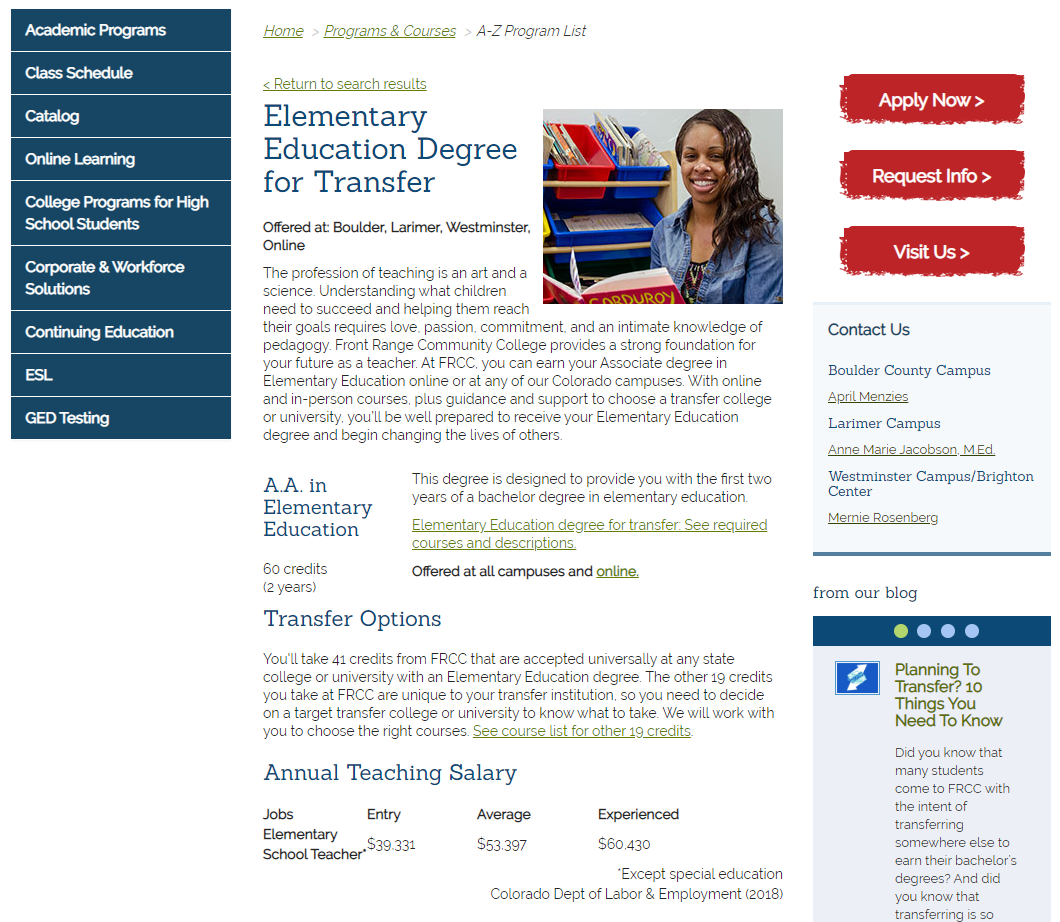
Last year, we called out CNU.edu for this same issue. They were ranked 42nd for their elementary education degree offering last year for the same exact reason. Here is how their page looked last year:
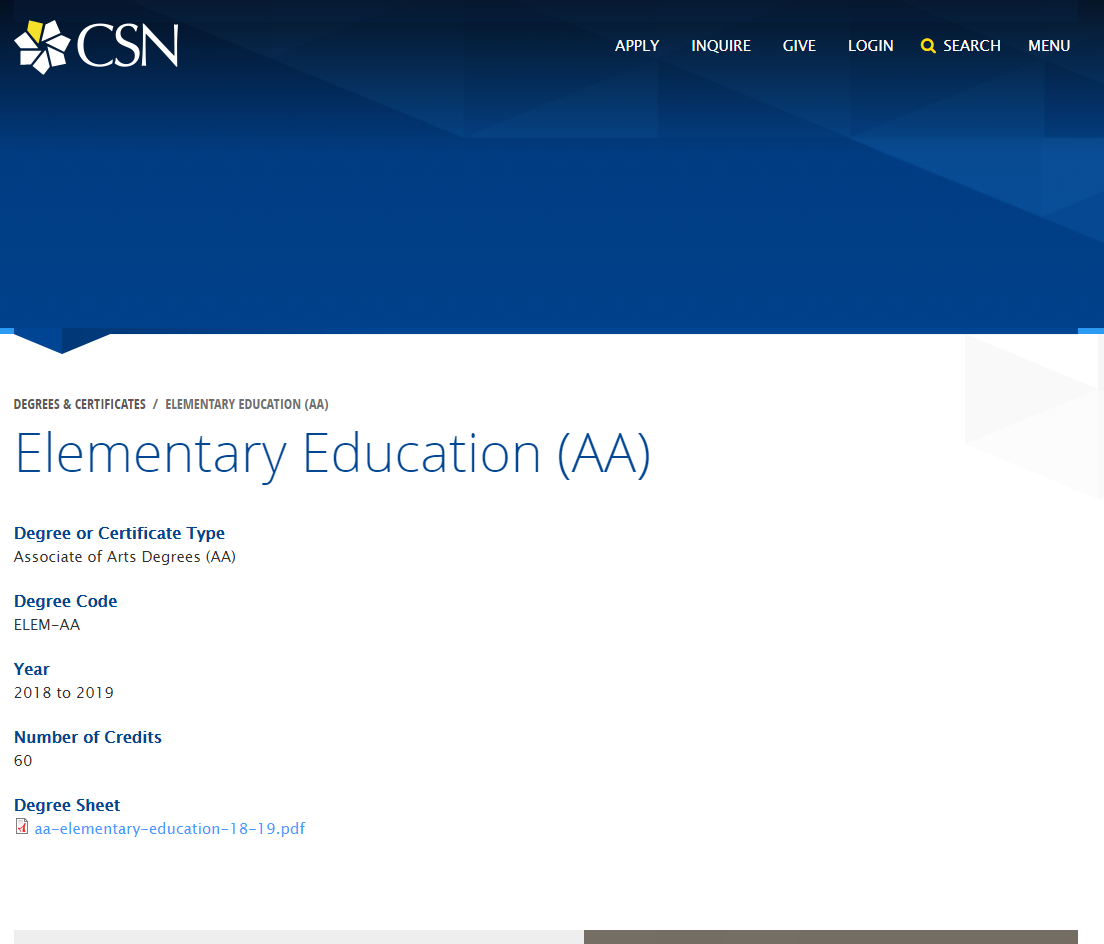
Yep, that's pretty much the whole page.
Did CNU.edu take our advice?
No.
I checked in on the page several times over the year and it never improved. At some point they decided to do the worst thing possible and redirect the page to their catalog and student handbook.
AND.. they still offer an elementary education degree. It's right here. It's not like they dropped the program and then redirected the page to the student handbook. They just straight dropped the page and redirected to the student handbook instead of the new degree page.
Listen up folks and Front Range Community College.. don't be like CNU. Take our advice and fill out the webpage and if you need to redirect it, redirect it to the new URL of the same offering.
Maybe have a content filled page much like WGU.edu who ranks on the first page for the same term and has a word count almost at 8,000?
If that is too much, waldenu.edu is ranking first page with a word count just shy of 2,500.
Now let's layer in our keywords.
Lots of random content alone won't rank you. You got to fit in those keywords too.
It's pretty crazy, but a lot of this reminds me of keyword stuffing from pre-2007 days. While I know a lot of you will disagree, a lot of you didn't do SEO back pre-2007 either. Not a dig, but basically more keywords = better rankings, and we are seeing that here too. It's just that, you got to fit it into more content now for this practice to work.
With more content comes the opportunity to fit in more keywords. The below image shows keywords in those tags.
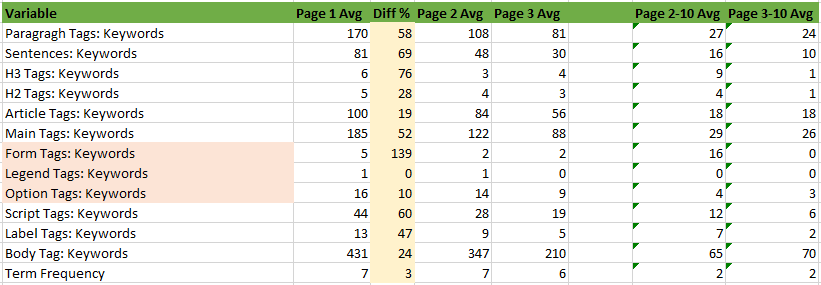
Several of these variables could be merged too.
Most of your sentences, are probably in paragraph tags. Both of those are probably in article tags. All of those, are in the body tag.
I just wanted to break it down so we get a good picture of things, but don't be blinded by this data breakout. Don't try to optimize every tag as many of these will be within others to begin with.
Tags that contain more of your keywords, end up ranking page 1 more often than pages that have tags that contain less keywords.
And just like last year, I found data that shows fitting in your keywords on FORM tags helps you rank if you are in the Higher Education vertical. I highlighted Legend and Option tags since those are primarily used within FORMs to help show overall the importance of this FORM tag to Higher Ed pages.
And while the data shows using keywords helps, it doesn't mean you should only be using your keywords in those tags.
Example, you shouldn't have a H2 tag that is just your keyword only. Our data shows keywords making up the entire tag did not impact rankings. Be sure to include your keyword, but don't make it the only thing in the tag.
Term Frequency was something that caught my eye. The 7 we get for page 1 and page 2 averages, isn't an average because we had a lot of 3's and then a lot of 11's as scores that averaged to a 7, it's an average because almost every ranking on Page 1 and Page 2 was a 7 itself.
Interesting....
I'll leave that alone for now. I think my silence on this speaks more than me trying to explain what you need to do.
Back to keywords in tags, this could be a reason why witchita.edu is sitting on the 5th page for "online rn to bsn program". Their body tag keyword score is only 42, when the average of page 1 is 431. Even page 3 is at 210. The page 2-10 average is even higher at 65.
Even their word count is low, just barely over 400 words for their page, which means they are not able to squeeze in more keywords in more places.
Term frequency is sitting at 5 for Wichita State University too.
The lesson here is, wake up Wichita State University! Add in more content and add in more areas to push your keywords more frequently.
And while I get that maybe "online rn to bsn program" could not be the term they are going for, they aren't sitting on the first 3 pages for any variation of that term either when I researched similar related terms like "rn to bsn online" and such.
Supporting LSI terms can help
While not always a deal breaker, LSI terms can help you break away and help show Google that your page's content isn't gibberish. This can provide you the push you need to break into the first 3 pages of a SERP.

Getting these LSI terms into the general content of your site might be what lands you on the first page.
Trying to use them in H1 or Title tags? Maybe not so much as the Diff % isn't huge.
Just use them intelligently within your content as needed with a focus on H2 tags, H4, and within your general content sentences.
Want to know how to get more LSI type terms for your content?
- Check out Google's AutoComplete dropdown suggestions
- Grab some of the "Related Searches" at the bottom of Google results
- Run a TF*IDF analysis
- Try a run of https://cloud.google.com/natural-language/, Google's Natural Language API.
An old school way I use to do something back in 2008 was to run a "word cloud" on my competitors ranking webpages and see which terms came up frequently on their pages I wanted to outrank.
But I didn't do this on 1 or 2 competitors, I did it on the entire front page for the term I wanted to rank for, making notes which terms came up frequently in the word cloud for each page and seeing where the trends came up.
Now rinse and repeat for variations of your term you want to rank and build yourself up a nice database of terms.
As an example, I ran content from a "Online Rn To Bsn Program" page from the SERPs on TagCloud.com and got these results back:

If I wanted to write content on "Online Rn To Bsn Program", I would for sure want to include the term "Nursing" on that content. Also maybe terms like "accredited", "education", and "excellence".
Run this type of analysis on the top 10 ranking websites for a given keyword, plus variations of that keyword, and you will start finding similar terms that probably need to be in your content when you write it since Google is ranking those webpages that contain those terms too.
Again, this was MY old school way of doing similar type of research over 12 years ago. You may find better alternatives today.
When I built the first SEO plugin for WordPress 2.0 many years ago, I used this same type of analysis within the plugin. It helped hundreds of thousands of people back then. The process can help you today as well.
If you end up using this and find it helpful, let me know in the comments!
No backlink data this update?
Yes. None.
While SERPWoo's Zora can help you spot on-page issues with your site ( or your competitors ) like the above Excel images, we don't have ready ( yet ) a backlink data source of our own.
Prior reports used data from Ahrefs and Majestics, as well as a few other sources.
And while I could have used those to fill in data about backlinks in this article, I decided to instead spend some time coding up SERPWoo's own version of a Ahrefs/Majestic backlink database instead.
It's not ready yet, but will be soon for paid members of SERPWoo totally free ( no extra cost ).
Wanna see what it *might* look like?
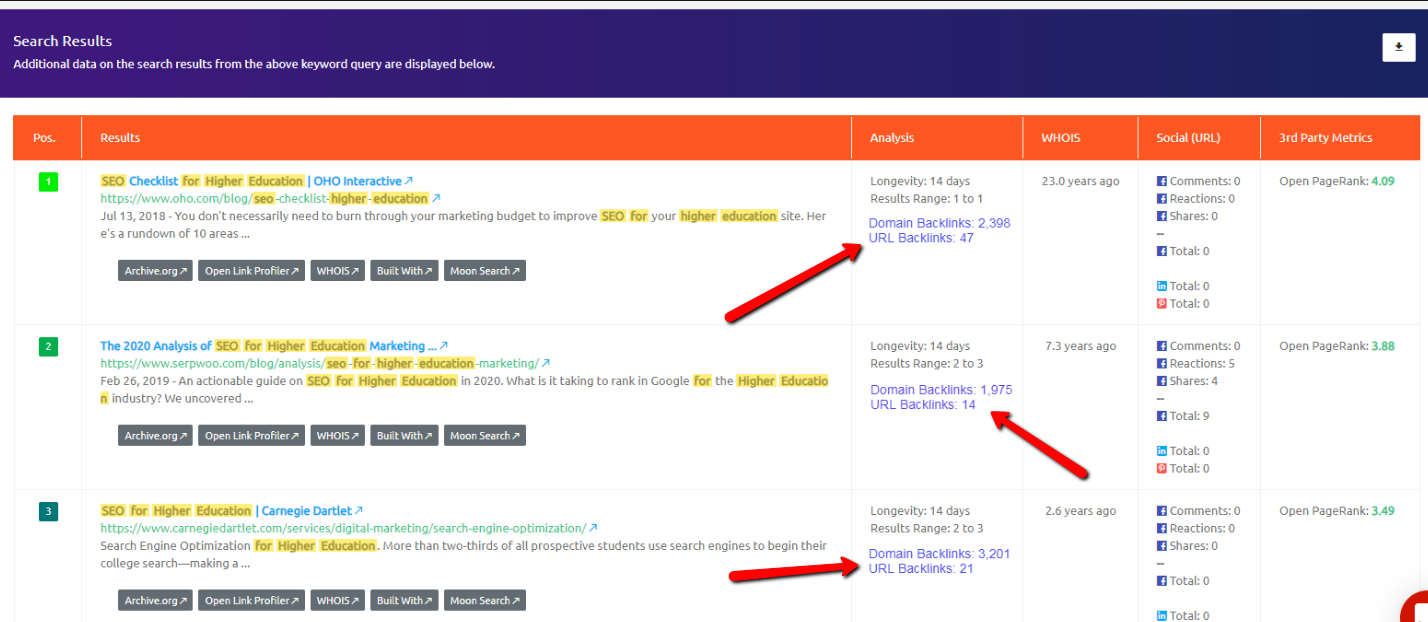
The red arrows point to the URL level and Domain level backlink counts for each result we find for you in the SERPs.
Now, also imagine clicking on those and getting all the backlinks for that result as well..
Both the backlink counts and export data will be available in a few months while I get it finished for you.
Nice, right?
This article will not contain backlink data this round, but we promise to have a much better feature for you waiting in the wings. Plus, we all know more links = better results, right?
It's a small sacrifice now, for a much bigger gain later on ( especially for you paid subscribers that get in before we raise our prices ).
So while everything I have shown you so far tells you how to rank on the first page, what about what it takes to hit the Top 3 positions?
What it takes to hit Top 3 in Higher Ed.
Our previous article included what it takes to rank, on the first page, of the Higher Education niche. This time we wanted to also include what it took to rank in positions #1-#3.
And guess what, the same patterns show up.
Patterns like, more content.

The above image are rankings #1-#10 ( the front page ) and their averages for each position.
We even grouped it as positions #1-#3 against positions #4-#10 and the percentage of the difference that we found between both.
Interesting find, right?
What took 3900 words on average to crack the first page, is taking almost 4800 words to crack the Top 3 on average.
And when it comes to layering in our keywords, the same pattern emerges.

Cracking the Top 3 really is focusing on getting more of your keywords into your content.
One thing I do want to focus on is LI Tags.
If you look at this image and the previous one, you will see that the #1 ranking almost never has the "most" of any variable we tracked. The number of H3 tags, word count, keywords in Main tags, etc.
The #1 rank almost always has less than #2 and sometimes #3.
That is, until you get to LI tags with keywords. This is the first time we see the #1 result take over a higher number than #2 and #3.
What I learn from this is that there is a threshold to crack the FRONT PAGE and even climb up to the Top 3, but that doesn't mean you will hit #1 rankings trying to "match and exceed" your competitors. Unless you're talking LI tags in this case.
We see something similar with LSI terms.

The #1 result has less than #2 and #3 until we look at LSI terms in the H2 tag.
Listen, I'm not saying adding more keywords and LSI terms to H2 tags and LI tags is the magic bullet, but they are interesting findings when you considering for almost every other variable the #1 result has less than #2 and sometimes #3.
Again, think thresholds for cracking the Top 3 and the front page with your content. Look at it as average, not exceeding and trying to bypass based on content alone.
When it's time to crack #1, you're going to need to look at backlinks and other assets.
If you want to see an example of cracking the front page with just about no backlinks, take a look at my series on "Ranking a new website from scratch".
Which BTW, I haven't wrote about yet.. but the site I am working on in that series has climbed to the 5th spot on the FRONT page of it's main term with almost no backlinks or SEO plan.. and it's a term dominated by big brands with old domains.
Here is a screen shot of the ranking as of 6-26-2020
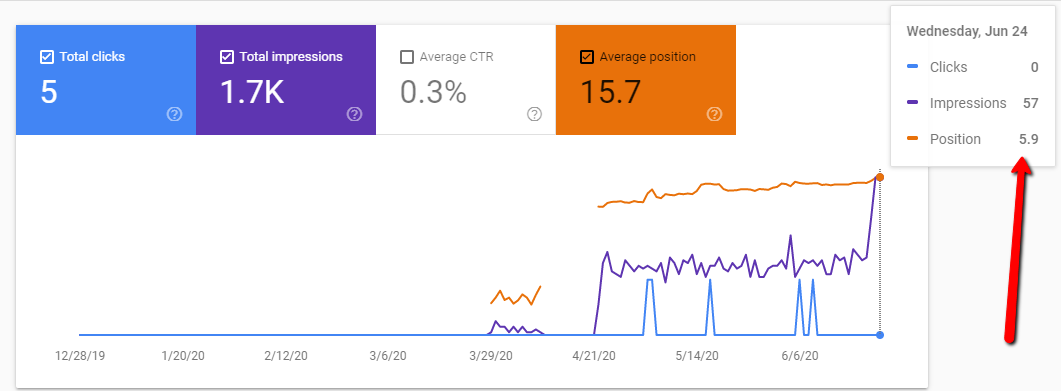
This domain is only 6 months old and has almost no backlinks, a very slow theme, no social signals really, and had no SEO plan until well into it's 4th month of being online.
And the term we are ranking front page on, it just about the largest term for it's niche in the B2B space.
Content alone can crack front pages for a lot of terms ( I didn't say all, keep it down everyone ). Once you have your content game down, you're gonna need backlinks and other assets to really move the needle when content can no longer do it for you in your SERPs.
Everyone's mileage is different. See how far you can go and then switch it up.
What do the day-to-day SERPs look like for Higher Education?
The majority of the keywords we examined were pretty solid and steady. I was really surprised honestly. After years of monitoring the Higher Education space with SERPWoo, I was expecting pretty volatile results again.
Most have very stable rankings for not only the first page, but the second page as well.
Lets look at some examples that monitor a keyword and the top 40 for the last 60 days:
Keyword: Child Psychology Degree Online
Last 60 days SERPs view, showing top 14 rankings pretty stable.

Keyword: Exercise Science Degree
Last 60 days SERPs view, showing top 8 rankings pretty stable.

Keyword: Online RN to BSN Degree
Last 60 days SERPs view, showing top 13 rankings pretty stable.

Keyword: Online Elementary Education Degree
Last 60 days SERPs view, showing top 10 rankings pretty stable.

I could keep posting more, but what I am finding today versus last year's article is that more websites are sticking around on the front page and many times the 2nd page too.
What use to be lots of volatility on the first page ( typically volatile from rankings #4 and below ), now tends to be volatile from rankings #8 and below. And for some keywords, #14-#15 and below.
Could the recent CORE updates, BERT, or Maverick have anything to do with this less volatile nature of the SERPs? Only more research can tell.
What that means for you is, it's getting harder and harder to crack the the 1st and 2nd page of SERP results for a given keyword now.
Makes sense, right? The less sites move around ( volatility ), the harder it is for websites to move up in the rankings.
Maybe this will change and revert back to more volatile rankings as time passes, but for now enjoy the traffic if you are already ranking.
Whose ranking for all these terms?
Another surprise was uncovered here, but I actually called it last year in suggesting that schools would get overtook by aggregators, affiliates, and informational websites when it comes to rankings because they just were not taking advice from professionals like myself.
7 out of the top 10 rankings, on average, are from non-university domains.
Meaning, non-EDU domains and non-school domains.
Now, that doesn't mean a school doesn't own the website. But most of these websites that are ranking tend to be informational research websites. Their first landing experience is not focused on primarily driving a lead to a form, like most colleges and university webpages do.
As an example, let's look at Exercise Science Degree and what type of sites are dominating the front page:
- https://www.exercise-science-guide.com/blog/what-can-you-do-with-exercise-science-degree/
- https://www.fitnessmentors.com/exercise-science-careers/
- https://www.bestvalueschools.com/rankings/best-bachelors-degrees-in-exercise-science/
- https://www.guidetoonlineschools.com/degrees/exercise-science
- https://www.collegeaffordabilityguide.org/subjects/exercise-science/
- https://bigfuture.collegeboard.org/majors/parks-recreation-fitness-exercise-science
- https://www.sports-management-degrees.com/faq/what-is-exercise-science/
This is what is going on for pretty much all of the Higher Education terms I have researched.
What's the takeaway from this little nugget?
That schools need to get on the ball with adding in more content to their websites if they want to focus on SEO for enrollment growth. Content that is informational and not lead generational. Content that is optimized and helpful.
This is what Google is rewarding and placing on the front page of SERPs at this moment.
And since those SERPs aren't very volatile anymore, this is what's going to continue to rank for some time.
It also tells me someone in the enrollment or marketing department needs to start planning out 2nd and 3rd properties outside of the main school website to start ranking and funneling students into their applicant pool. A backup plan for when the .EDU site doesn't rank anymore and fails to bring in search traffic.
In my experience of helping over 50+ universities and colleges over the years, almost none of them put efforts outside of their .EDU websites and now it is coming to haunt them.
Why wouldn't you have a backup website? Backup website for SEO, backup website for PPC, etc...
Many of them are now stuck paying for leads from affiliates and aggregators.
Of all the terms we monitored and research, one school stood out from the rest, and that was SNHU.edu who ranked somewhere in the TOP 10 for many of our keywords.
If you wanted some idea of a university doing it right, these are the examples I would look at:
- https://www.snhu.edu/online-degrees/associate/as-in-business-administration
- https://www.snhu.edu/online-degrees/bachelors/ba-in-psychology/child-and-adolescent-development
I'm not going to list all of their pages and out their terms except for the small sample above. These 2 pages should be enough to help you get the main idea of what they are doing right, and what you might be doing wrong ( as a university or college looking to compare ).
However, if you wanted to start finding more keywords and pages on your own I can help. Just replace the X portions with your desired keyword and change out for degree level as well ( Bachelor and Ba ):
- Ba Degree In XXXXX
- Ba Degree In XXXXX Online
- Ba In XXXXX
- Ba In XXXXX Degree
- Ba In XXXXX Degree Online
- Ba In XXXXX Online
- Bachelor Degree In XXXXX
- Bachelor Degree In XXXXX Online
- Bachelor In XXXXX
- Bachelor In XXXXX Degree
- Bachelor In XXXXX Degree Online
- Bachelor In XXXXX Online
- Bachelor Of Arts Degree XXXXX
- Bachelor Of Arts Degree XXXXX Online
- Bachelor Of Arts Degree In XXXXX
- Bachelor Of Arts Degree In XXXXX Online
- Bachelor Of Arts XXXXX
- Bachelor Of Arts XXXXX Degree
- Bachelor Of Arts XXXXX Degree Online
- Bachelor Of Arts XXXXX Online
- Bachelor Of Arts In XXXXX
- Bachelor Of Arts In XXXXX Degree
- Bachelor Of Arts In XXXXX Degree Online
- Bachelor Of Arts In XXXXX Online
- Bachelors Degree In XXXXX
- Bachelors Degree In XXXXX Online
- Bachelors In XXXXX
- Bachelors In XXXXX Degree
- Bachelors In XXXXX Degree Online
- Bachelors In XXXXX Online
- Bachelors Of Arts Degree XXXXX
- Bachelors Of Arts Degree XXXXX Online
- Bachelors Of Arts Degree In XXXXX
- Bachelors Of Arts Degree In XXXXX Online
- Bachelors Of Arts XXXXX
- Bachelors Of Arts XXXXX Degree
- Bachelors Of Arts XXXXX Degree Online
- Bachelors Of Arts XXXXX Online
- Bachelors Of Arts In XXXXX
- Bachelors Of Arts In XXXXX Degree
- Bachelors Of Arts In XXXXX Degree Online
- Bachelors Of Arts In XXXXX Online
- Degree XXXXX
- Degree XXXXX Online
- Degree In XXXXX
- Degree In XXXXX Online
- Degrees XXXXX
- Degrees XXXXX Online
- Degrees In XXXXX
- Degrees In XXXXX Online
- XXXXX Ba
- XXXXX Ba Degree
- XXXXX Ba Degree Online
- XXXXX Ba Online
- XXXXX Bachelor
- XXXXX Bachelor Degree
- XXXXX Bachelor Degree Online
- XXXXX Bachelor Of Arts
- XXXXX Bachelor Of Arts Degree
- XXXXX Bachelor Of Arts Degree Online
- XXXXX Bachelor Of Arts Online
- XXXXX Bachelor Online
- XXXXX Bachelors
- XXXXX Bachelors Degree
- XXXXX Bachelors Degree Online
- XXXXX Bachelors Online
- XXXXX College
- XXXXX College Online
- XXXXX Colleges
- XXXXX Colleges Online
- XXXXX Degree
- XXXXX Degree Online
- XXXXX Degrees
- XXXXX Degrees Online
- XXXXX Program
- XXXXX Program Online
- XXXXX Programs
- XXXXX Programs Online
- XXXXX School
- XXXXX School Online
- XXXXX Schools
- XXXXX Schools Online
- XXXXX Universities
- XXXXX Universities Online
- XXXXX University
- XXXXX University Online
- Online Ba Degree In XXXXX
- Online Ba In XXXXX
- Online Ba In XXXXX Degree
- Online Bachelor Degree In XXXXX
- Online Bachelor In XXXXX
- Online Bachelor In XXXXX Degree
- Online Bachelor Of Arts Degree XXXXX
- Online Bachelor Of Arts Degree In XXXXX
- Online Bachelor Of Arts XXXXX
- Online Bachelor Of Arts XXXXX Degree
- Online Bachelor Of Arts In XXXXX
- Online Bachelor Of Arts In XXXXX Degree
- Online Bachelors Degree In XXXXX
- Online Bachelors In XXXXX
- Online Bachelors In XXXXX Degree
- Online Bachelors Of Arts Degree XXXXX
- Online Bachelors Of Arts Degree In XXXXX
- Online Bachelors Of Arts XXXXX
- Online Bachelors Of Arts XXXXX Degree
- Online Bachelors Of Arts In XXXXX
- Online Bachelors Of Arts In XXXXX Degree
- Online Degree XXXXX
- Online Degree In XXXXX
- Online Degrees XXXXX
- Online Degrees In XXXXX
- Online XXXXX Ba
- Online XXXXX Ba Degree
- Online XXXXX Bachelor
- Online XXXXX Bachelor Degree
- Online XXXXX Bachelor Of Arts
- Online XXXXX Bachelor Of Arts Degree
- Online XXXXX Bachelors
- Online XXXXX Bachelors Degree
- Online XXXXX College
- Online XXXXX Colleges
- Online XXXXX Degree
- Online XXXXX Degrees
- Online XXXXX Program
- Online XXXXX Programs
- Online XXXXX School
- Online XXXXX Schools
- Online XXXXX Universities
- Online XXXXX University
These keywords should get you started down the path to monitoring SERPs in SERPWoo and finding out true competitors and which keywords to tackle first.
Conclusion
This is our 2nd "What it takes to rank in the Higher Education niche" article and our 5th article in "What it takes to rank in X niche".
I wanted to share what it really takes to rank in different niches instead of having you listen to so called "digital marketing" experts who haven't ranked a website in their life.
Or those that just regurgitate what someone else said on a blog 3 years ago.
Most of them just say "more content" or "more backlinks" and you are just supposed to blindly follow them.
But how many of them are offering you breakdown analysis of each SERP page? Or each SERP on the front page?
How many of them are telling you exactly what works in your specific niche?
And here is a clue, not everything that works in one niche, works in another.
Exactly the reason SERPWoo was invented, to find out what exactly works for you and your specific keywords.
What was working last year ( such as keywords in the first or last 100 words and count of images ), isn't so much a ranking variable now.
And doing this frequently is the key to winning in the SERPs. Things will change in the next 90 or 180 days. Are you going to put in the work to find the new changes, or will your SEO team still be executing on old data that is no longer relevant?
This is why you need SERPWoo and SERPWoo's Zora.
Shameless Plug
So here's a serious question.
Are you a school or higher education marketing agency looking for help with your digital strategy in 2019?
I'm currently looking to partner with a few select higher education clients that could benefit from my prior experience in helping over 50 schools reduce their marketing costs, improve their enrollments, and drive growth for their ground and online programs.
If interested, shoot me an email to see if we're a match today.
Oh, and if you want to get more detailed reports like this, sign up for a paid SERPWoo account. We send out monthly exclusive guides like this to our paid members that include content found nowhere else online!
